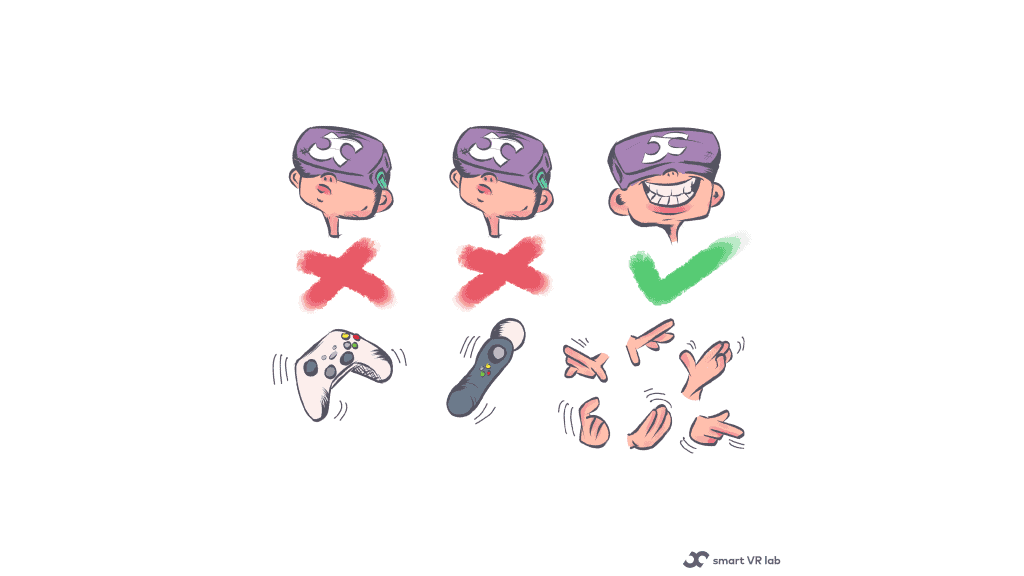Virtual reality is an evolving technology. Usually, VR users control things in the virtual world using controllers. Since the hand tracking technology made its debut in the VR world, it has definitely altered the way people use their VR headsets.
The hand tracking technology promises a future where there will be no more hassle with the VR experience. Things like pushing the wrong buttons on the controller, running out of battery or even just simply struggling with using the controllers.
Here are the top 10 reasons why hand tracking in VR is better than controllers.
1. No necessity to learning buttons
When using the VR headset for the first time, you usually need to learn the buttons. You will have to use muscle memory in order to remember the locations of each button on the controller. This is because, once you put on the VR headset, you will no longer be able to look at your controller to figure out each button’s location on the controller.
Also, when learning a new video game, or software, you usually need to learn the functions of the buttons. Which button does which move with how much precision. Each software comes with a different set of instructions. Each software has a different set of use cases for the buttons. This is because not every software does the same functionalities.
2. Hands are universal
Hands are universal, while controllers are not. Every controller has its own ergonomics and set of buttons. This is a hassle for some people to even learn the usage of controllers.
On the contrary, hands have the same way of using them. They come with instructions that are already learnt since the day you were born. The usability with VR headsets is universal. Everyone simply knows how to use their hands.
3. Expressing yourself
Humans have many ways to interact with each other. Body language is one of many ways of human expression. Doing things like waving, high-fiving or pointing at something feels a lot more natural than “Press X for pointing”
4. More Hygienic
A study by UNICEF and Domestos show that home gaming console controllers have FIVE TIMES more germs than a toilet seat. This proves that obviously, hands are more hygienic than controllers.
Unlike physical controllers, you constantly wash your hands. you don’t need to buy extra products for cleaning your hands. With the current Coronavirus pandemic, hand tracking could reduce the transmission of diseases.
5. No need to charge
Controllers always need to have charge to be up and running. With hands, you don’t have to worry about charging then or running out of battery. Just pick up your headset and immerse yourself in the virtual world.
6. Deeper immersion
One of the most powerful ways to create presence in VR is simply to be able to look down and see your hands, reacting and moving in real-time. Seeing this tells your brain it’s real.
Fumbling around for VR controllers after you put the headset on is also pretty distracting and bad for immersion. And in large-scale VR, such as theme park rides and art installations where each user’s time is limited, it wastes valuable minutes.
7. Haptic feedback is still possible
VR Controllers come with high-end haptic feedback. Everyone loves it and wouldn’t want to lose it. Thanks to contactless haptics, such as Ultraleap’s technology, experiencing the sense of touch in mid-air is possible.
8. Hands are more powerful
Your hands are more powerful tools than any VR controller. They have 27 degrees of freedom, and the ability to detect an object the size of a molecule. They can pinch and poke seamlessly. This goes to show that your hands can do more functions, they can do them at a faster pace and in a more precise manner.
9. Picking affordances and not the hardware manufacturer
Hands can do everything a VR controller can, but they can also do more.
For many applications, simple binary actions (pinch, grab, push, trigger) are all you need. But if you want users to be able to sculpt digital materials or manipulate sound waves as though they were physical objects, that’s possible too. Hand tracking lets us develop ways of interacting that fit the application – not the other way around.
10. Hands are the only possible interface for AR
Handheld controllers will always be popular accessories for home VR, as long as people want to wield guns or swords.
But with the rise of mobile platforms, AR, and applications beyond gaming in enterprise, out-of-home entertainment, education and healthcare, the future of VR interaction in the 2020s is literally in your hands.
No one will want to walk down the street or through the office with controllers strapped to their wrists, making hand tracking the only viable interface for AR. As VR and AR blend together under the broader categories of XR and spatial computing, a single universal interface will need to bridge these various platforms and user experiences.
Conclusion
In conclusion, hand-tracking technology has definitely changed the way people use their VR headsets. This goes beyond the consumer market as even businesses that use VR in operations, training and other business-related activities use this technology too.
VR headsets can also be controlled with neither the controller nor the hand-tracking technology. This is possible with the technology that has just recently made its way to the VR industry. To learn more, read: How to control VR using your mind.
If you want to build a VR app that works with hand tracking for your business, then Smart VR Lab can help. Smart VR Lab develops and produces training content for businesses across multiple industries. To transform the way your business trains its staff, simply contact Smart VR Lab for a demo and set up a meeting with our team.
If you have questions on anything related to VR, you can always send us a mail to info@smartvrlab.nl

